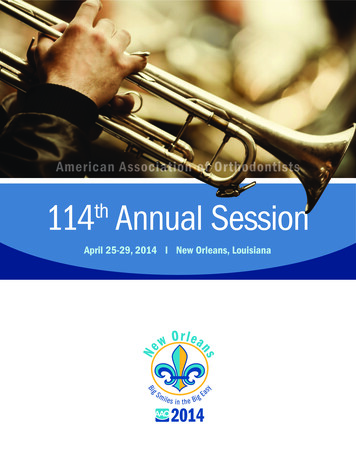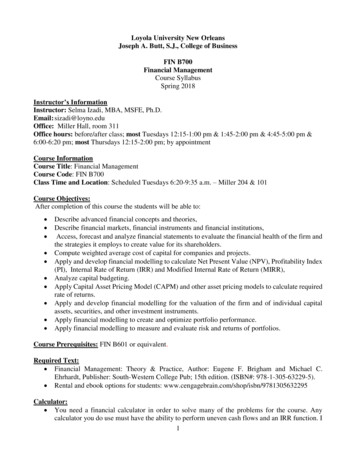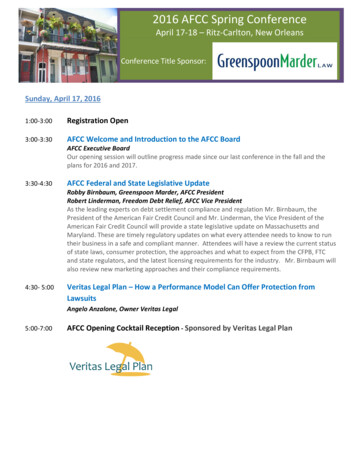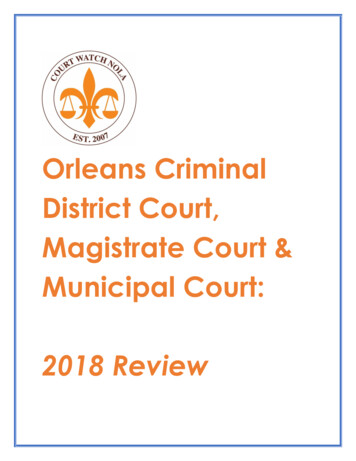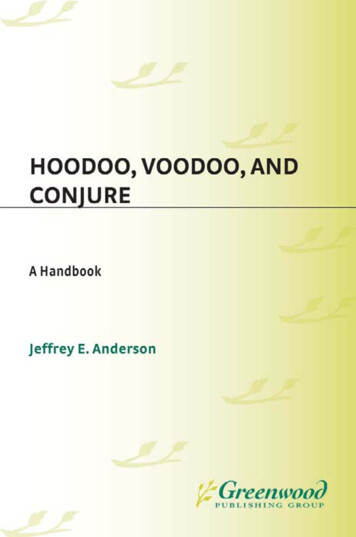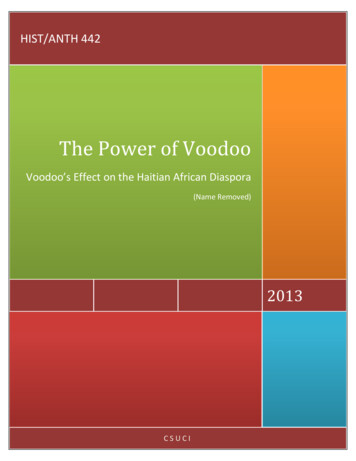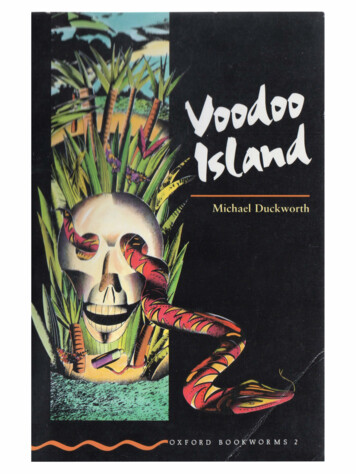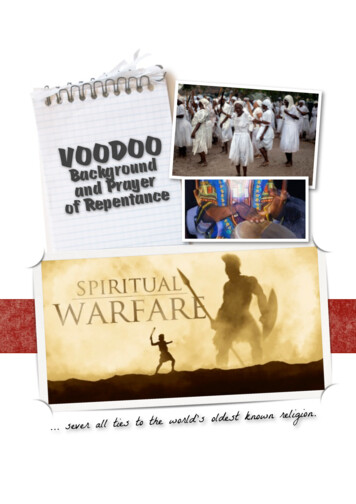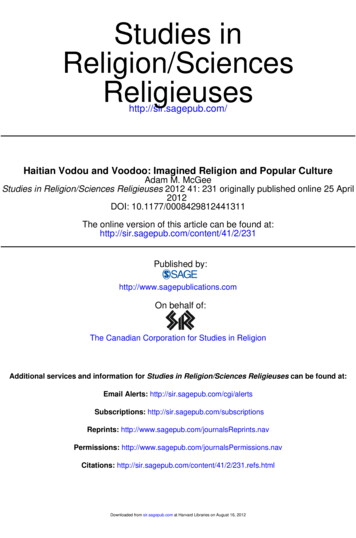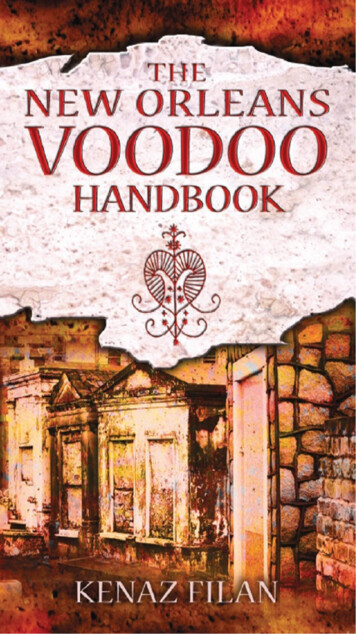
Transcription
THE NEW ORLEANSVOODOOHANDBOOK“To understand a spiritual practiceone must understand both the historyand culture in which it flourished. InTheNewOrleansVoodooHandbook, Kenaz Filan begins withthe critical eye of a historian beforeinvestigating New Orleans Voodooas both a spiritual science andreligion. He strips away myth andfallacy, leaving us with fact, andgives us an insider’s view of thefaith’s deepest mysteries. It is thefirst book I’ve read by anexperienced houngan dealing withone of the South’s most enduring,powerful legacies. This volume is awelcome addition to both the casual
historian’s and active practitioner’slibrary.”OCHA’NI LELE,AUTHOR OF DILOGGÚN TALESOF THE NATURAL WORLD,TEACHINGS OF THE SATERÍAGODS, ANDTHE DILOGGÚN: THEORISHAS, PROVERBS,SACRIFICES, ANDPROHIBITIONS OF CUBANSANTERÍA
CONTENTSCover ImageTitle PageIntroductionPART ONEHISTORYChapter 1 — Born on the Bayou: TheRise of New OrleansLa Salle’s ExpeditionGovernor Bienville’s CrescentCityLouisianaBecomesCajunCountrySpanish RuleChapter 2 — From Saint-Domingue toWashington: Revolution Comes toLouisiana
The Haitian RevolutionSaint-Domingue Comes to NewOrleansThe Battle of New OrleansNew Orleans Voodoo, HaitianVodou?Chapter 3 — King Cotton, LadyLiberty, and Jim CrowSteamboats and Cotton GinsFeasting and Carousing in theCrescent CityThe Civil War: New Orleansunder OccupationReconstruction and Its AftermathPlessy v. FergusonChapter 4 — The (Re)creation of “NewOrleans Voodoo”Zora Neale HurstonRobert TallantCharles Massicot Gandolfo
Chapter 5 — When the Levee Breaks:Hurricane KatrinaPART TWOTRADITIONSChapter 6 — Mardi GrasBefore Easter—and AfterMardi Gras Comes to NewOrleansThrowsKings and QueensChapter 7 — MusicDelta BluesDixieland JazzZydecoChapter 8 — FoodJambalayaGumboPralines
Coffee with ChicoryCrawfishChapter 9 — Voodoo Temples andCurio ShopsThe Cracker Jack DrugstoreThe Temple of Innocent BloodThe Voodoo Spiritual TempleThe Island of Salvation BotanicaThe Westgate MuseumBoutique du VampyreChapter 10 — Priests, Priestesses,Houngans, Mambos, and ChickenMenJean “Doctor John” MontaigneThe Seven Sisters of NewOrleansFred “Chicken Man” StatenPART THREETHE SPIRITS
Chapter 11 — The Old Man at theCrossroads: Papa La-BasSt. Peter, Papa Limba, and PapaLa-BasTales of Papa La-BasThe Old Man at the CrossroadsChapter 12 — The Divine Mother: TheVirgin MaryMariologyOur Lady of Prompt SuccorThe Holy RosaryChapter 13 — The Great Serpent: LiGrand ZombiThe Snake Dances of NewOrleansNzambi, Simbi, and Li GrandZombiSt. Michael the Archangel—orMr. Daniel BlancChapter 14 — The Voodoo Queen:
Marie LaveauBirth and First MarriageChristophe GlapionThe Voodoo QueenThe Tomb of Marie Laveau(s)Chapter 15 — The Warriors: JoeFéraille, St. Marron, and Yon SueJoe FérailleSt. MarronYon SueChapter 16 — The Miracle Workers:St. Expidité, St. Jude, and St. RochSt. ExpeditéSt. JudeSt. RochChapter 17 — The Bringers of GoodFortune: St. Joseph, Assonquer, andJohn the ConquerorSt. JosephAssonquer
John the ConquerorChapter 18 — The Indians: BlackHawk and the Black Hawk SpiritualChurchesLeafy Anderson and Black HawkWorking with Indian SpiritsYellow Jacket and Money MagicArchetypes and StereotypesChapter 19 — The Roots: The DeadThe Cemeteries of New OrleansHaunted New OrleansSafer Ghost HuntingPART FOURPRACTICESChapter 20 — CandlesCandle ColorsCandle SizesPreparing Candles
Figural CandlesReading Your Candle WorkingChapter 21 — OilsVan Van OilFollow Me Boy OilRed Fast Luck OilAlgiers Triple Strength OilHas No HannaChapter 22 — Spirit DollsFeitiços, Fetishes, and MinkisiPoppetsReligious Statues and ImagesChapter 23 — Mojo Hands and Grisgris BagsGris-gris in Africa and AmericaCreating Your Own Mojo HandHigh John the Conqueror Rootand Its RelativesChapter 24 — Foretelling the Future
Crystal BallsTea Leaf ReadingCartomancyDream Interpretation and PolicyBooksPART FIVEJUST VISITING orSettling DownChapter 25 — Visiting the Big EasyVoodoo Shops and StopsRestaurantsMusicCemeteriesChapter 26 — Moving to New Orleans:Triumphs and TragediesTennessee WilliamsEmeril LagasseWilly DeVille
Zackery BowenAfterword:DeepwaterHorizon and theIndomitable Spiritof LouisianaPART SIXAPPENDICESAPPENDIX 1 — Great New OrleansBooks, Movies, and TelevisionBooksMovies and TelevisionAPPENDIX 2MusiciansAPPENDIX 3OrleansFootnotes— NewOrleans— Preserving New
EndnotesAbout the AuthorAbout Inner Traditions Bear &CompanyBooks of Related InterestCopyright & Permissions
INTRODUCTIONMany people will tell you that there isno such thing as New Orleans Voodoo.According to them, the whole thingstarted as a marketing campaign to wootourists. Later, a few bored white folkscreated a “tradition” by reading somebooks on African and Afro-Caribbeanspirituality, then combining thatinformation with African American folkmagic, Wicca, hermeticism, and justabout anything else they could find thatwas suitably “mysterious” and“spooky.” Those criticisms aren’tentirely without merit. And yet they missthe greater point: New Orleans Voodoohas become for many a powerful andmeaningful religious tradition.The critics may have a point. Theremay not have been a survival of HaitianVodou that persists to the present day in
the Louisiana backwoods and bayous.But, like most creation myths, the storiespoint to a deeper truth. There issomething magical in the Crescent City,some force that powers New OrleansVoodoo and that draws people to itsholy land for pilgrimages and parties(which have often been closely linked,despite what you may have heard inSunday school). The explanations maynot be literally true, but that’s notimportant. What’s important is that thecreation myths point to something thatmust be explained.The French philosopher JeanBaudrillard has spoken of simulacra—signs, symbols, and simulations that aretreated as and become reality. As he putsit, “Simulation . . . is the generation bymodels of a real without origin orreality: a hyperreal. The territory nolonger precedes the map, nor does itsurvive it. It is nevertheless the map thatprecedes the territory—precession of
simulacra—thatengendersthe1territory.”Perhaps the legends created NewOrleans Voodoo. If so, that creation haslong since taken on a life of its own. Themyth has sired many children and hascalled others to listen and to learnbeneath the city’s wrought-ironbalconies. But many believe somethingelse is behind the stories. They have feltthe reality behind the magic; they havedrunk from the water of LakePontchartrain, and now the city hasclaimed them for her own.You may feel her calling out to you inyour dreams. You may long for herbrightly colored shotgun cottages and thejazz bands playing in her streets. Or youmay just be looking for a new spiritualdiversion. Your motivations are yourown; whatever you want, you’ll find thatNew Orleans is happy to oblige you. Butbe careful. Those who know the citywill tell you that there’s plenty of danger
to go with the beauty. If you don’t watchyourself, you may just wind up suckedinto something you never bargained for.She’s a sweet mistress, but she can be aharsh one too. Take her joyfully, take herlovingly, but don’t you dare take herlightly.Because, you see, that’s the way realmagic is. Real magic is as joyful and sadas a jazz funeral, as pretty and asdangerous as white oleander. If you wantto experience the spirit world, be readyfor beauty that will bring tears to youreyes and for terrors that will scare youwitless. There’s plenty of both in NewOrleans, and those who will share in herdreams had best be prepared to face hernightmares too. Lots of visitors whooverindulged in Bourbon Street’s barshave awakened without their wallets andcell phones, and many spiritual touristswho took New Orleans Voodoo for aharmless game found themselves face toface with things they hadn’t expected.
Those who escaped alive rarely got outunscathed. Like many who came beforethem, they left with scars as souvenirs oftheir journey to the Big Easy.Unlike Haitian Vodou or other moreorganized Afro-Caribbean traditions,New Orleans Voodoo is a freeformsystem of worship. You can incorporatewhatever works for you into yourpersonal practices, and nobody will tellyou that you’re doing it wrong. On theother hand, no one is going to tell youthat you’re doing it right. Like anyconjure person, you’ll have to judge thatby how your magic does or does notwork. New Orleans Voodoo is not aboutadherence to a doctrine or a script; it’sabout working with the spirits to bringabout changes on the material plane.For those coming to New OrleansVoodoo from a more structuredtradition, this can be simultaneouslyexhilarating and terrifying. You candeclare yourself a conjure man, a root
doctor, or a Voodoo Queen—but thenyou’ll be expected to deliver theservices appropriate to your selfproclaimed title. You’ll be judged not bywho initiated you or how well you havememorized the proper prayers, but bywhether you can do the work for yourclients and yourself. If you can’t, you’rejust an empty title, a poor deluded soulpretending to have power you’ll neverhave.I have provided you withintroductions to some of the spirits mostcommonly honored in New OrleansVoodoo, as well as safeguards that mayhelp you to avoid psychic or physicalinjury. But, in the end, the instructionsI’ve provided here are merelyguidelines. It’s up to you to make theacquaintance of the spirits, and it’s up toyou to accept responsibility for thechanges they may bring into your life—and you can rest assured they will bringchanges. When you call on the lwas,
don’t be surprised when they answer.
PART ONEHISTORYTo understand New OrleansVoodoo,youmustfirstunderstand the city. New Orleansis a conglomeration of races,classes, and cultures unlikeanyplace else in the world. Itsterrain, its history, and its peoplehave all contributed to itstriumphs and tragedies, and havehelped to shape its religious andmagical practices.History should not be treatedas a dull collection of names,dates, and events, but as acelebration of the achievementsof those who have gone beforeus. (Besides, only a trulydetermined historian could makethe story of New Orleans boring.)With that in mind, let’s pay ajoyous, if sometimes somber,
tribute to the people who madethe Big Easy what it is today.
1BORN ONBAYOUThe RiseOrleansofTHENewAs the Mississippi flows south fromMinnesota’s Lake Itasca, it joins withother great streams like the Ohio, theArkansas, and the Missouri rivers. Eachof these brings with it a payload of richMidwestern soil. By the time the riverreaches its mouth, the waters of the “BigMuddy” are heavy with silt. Flowinginto the Gulf of Mexico, it deposits thesediment in the brackish area where saltand freshwater meet. The result is a fanshaped landform that resembles theGreek letter “D” and that is hence calleda delta. The delta fills in the riverchannel as it grows, and water pressure
digs out a new path through the soft earthas the old one becomes clogged.Rivulets are born and die to be rebornagain; limpid pools and creeks formamid the bogs and marsh grasses. TheChoctaw called these small, slowmoving streams bayuks; the settlers whocame after them called them bayous.This swampy delta ecosystem teemswith life—not all of it friendly tohumans. Venomous cottonmouths andcopperheads lurk amid the reeds, andwhat looks to be a fallen log might be asleeping alligator. The swarms ofmosquitoes are a torment at best andpotential carriers for malaria and yellowfever at worst. And while avoiding thenative fauna, one also needs to look outfor quicksand and pitfalls hiddenbeneath the verdant undergrowth. Butthose who are able to overlook thesedrawbacks will find many treasures inthe marshes. Thanks to their waterprooffur, beaver skins can be used to make
weather-resistant hats and coats. Thebayous teem with crayfish, and themarshes and estuaries are home to manyshrimp, turtles, and fish.But New Orleans has something moreimportant going for it—as real estateprofessionals say, it has “location,location, location!” New Orleans is thenatural port of the Mississippi Valley.Goods produced throughout the Midwestcan be shipped down the wide river tothe Gulf of Mexico, and from there tomarkets around the world. In exchange,items from Latin America can be sent upthe river to reach consumers inAmerica’s heartland. Throughout itsreach from New Orleans to the GulfCoast, the Mississippi is both wide anddeep, so large vessels can land therewithout difficulty. Like many ports, NewOrleans is a multicultural city—but itsmulticulturalism (and its magic) has apronounced French accent.
La Salle’s ExpeditionIn 1677 French explorer René-RobertCavelier, Sieur de La Salle, received acommission from King Louis XIV to finda water passage through North America.La Salle had made many salliesthroughout New France, includingexplorations of Lakes Michigan, Huron,Ontario, and Erie. Building upon theexpeditions of Louis Jolliet and FatherJacques Marquette, who had mapped thenorthern reaches of the MississippiRiver, he set out to find what hebelieved to be a short cut to the lucrativemarkets of China.After several setbacks (includingmutinous soldiers, sunken ships, andburning forts), La Salle finallysucceeded in reaching the Mississippion February 6, 1682. By April 9 hereached the river’s mouth. There, nearmodern-day Venice, Louisiana, heerected on the shore a cross and a
column engraved with King Louis’ nameand claimed the territory of “LaLouisiane” for France. Returning toCanada and thence to France, he askedthe king for support in colonizing thisvast new territory. In July of 1684 he setsail with four vessels and 250 men. Butonce again La Salle ran into difficulties,this time from pirates and hostileIndians. Instead of French Louisiana,they landed on the coast of the Spanishlands that now make up part of Texas.By 1687, after multiple failed effortsto locate the Mississippi River, LaSalle’s remaining men grew t
The New Orleans Voodoo Handbook, Kenaz Filan begins with the critical eye of a historian before investigating New Orleans Voodoo as both a spiritual science and religion. He strips away myth and fallacy, leaving us with fact, and gives us an insider’s view of the faith’s deepest mysteries. It is the first book I’ve read by an experienced houngan dealing with one of the South’s most .
